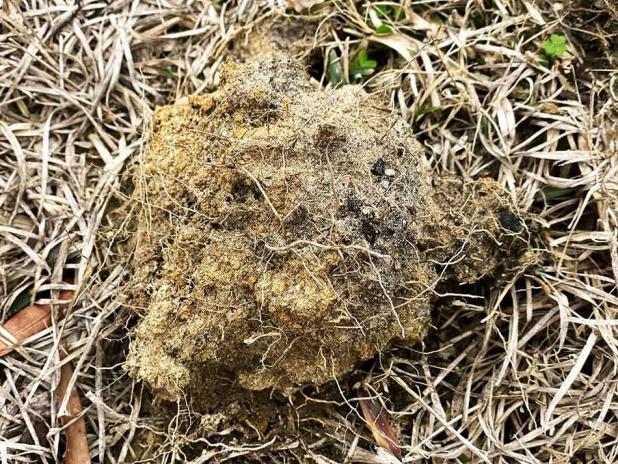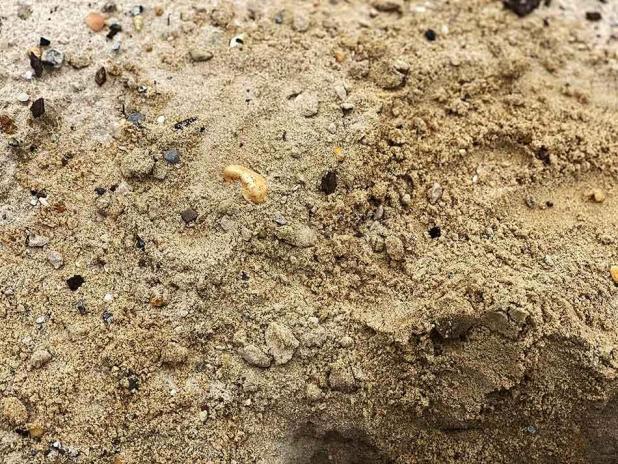
Clay has the smallest or finest particle size in soils. It expands when moist and contracts when dry.
—LSU AgCenter Photos/Heather Kirk-Ballard

Sand has the largest particle size, which helps improve aeration, or oxygen exchange.
Get It Growing: Get ready for spring gardening
As we approach spring in Louisiana, now is a good time to start prepping your landscape and vegetable gardens for plants.
Knowing your soil composition is the best place to start. If you understand the nutritional composition and condition of your soil, you will be a more successful gardener.
Plants need some essential things to thrive: sun, air, water and food (nutrients). Soil tests are not required, but they can tell you a great deal about what’s going on where your plants live.
Soils are extremely important to the success of your gardens. They support our plants by not only giving them a place in which to grow their roots, but they also provide essential nutrients, water and oxygen. The best garden soil should have a proper balance of minerals, water, organic matter and air.
Soils are composed of clay, organic matter and sand, and they all have different particle sizes. Sand has the largest particles, while clay has the smallest. Silt falls somewhere in between. They combine in different ways to form many different soil textures.
A good soil has a balanced mixture of sand, clay and organic matter. Sand, silt and clay determine soil texture, but it is the organic materials consisting of microbes, fungi and decayed plant matter that improve soil structure. An ideal soil is composed of 45% minerals (gravel, sand, silt or clay), 25% water, 25% air and 2-5% organic matter, give or take a few.
Nutrients come from the organic matter in the soil. Decayed plant materials contain carbon (C), oxygen (O), hydrogen (H), nitrogen (N), phosphorus (P), potassium (K), calcium (Ca) and magnesium (Mg) as well as other nutrients in smaller amounts. All of these nutrients are key to soil fertility and plant health.
Microorganisms also are an active organic portion of soils, making up 10-40% of the organic matter. This is in addition to about 40-60% of humus, which is a stable form of organic matter.
Know what you’re starting with by taking a soil sample and sending it to the LSU AgCenter Soil Testing and Plant Analysis Lab. Soil sample kits can be found at many local retail nurseries and at AgCenter offices. The results will tell you the composition of your soil, and the lab will make recommendations on how to optimize it by providing valuable feedback on fertilizer and pH.
As far as soil pH goes, it is an indication of the acidity or alkalinity of your soil. Plants actually prefer a slightly acidic soil at a pH of around 6.5. At the correct pH, your plant will have the optimum availability of soil nutrients. If your soil pH is off, plants may not be able to uptake some nutrients.
To adjust soil pH, you can use acidifying fertilizers or lime. For more information on soil pH and how to adjust it, go to LSUAgCenter.com and search for the “Louisiana Home Lawn Series: Soil pH” publication.
Soils that lack nutrients can be improved by adding organic matter, or what we commonly refer to as soil amendments. Amendments are mixed into the topsoil to improve soil texture and nutrient content.
You can use no-cost or low-cost amendments such as locally sourced manure, compost and compost tea, leaves, grass clippings and kitchen scraps from your own home.
Here is a brief list of common soil amendments that can be found at local nurseries or garden centers: compost, peat moss, mycorrhizae, topsoil, composted manure, worm castings, wood ashes, mushroom compost, biochar and many others. Just think “natural” when you are thinking of organic materials, and you cannot go wrong.
In general, soils high in organic matter will retain more moisture, have improved drainage and aeration (oxygen), resist compaction and have higher levels of nutrients that improve plant growth.
Fertilizers also can be used to improve nutrient content in the soil; however, caution should be taken when using them. When fertilizing, it is important to apply at the proper rate following the label instructions to prevent runoff into surface waters such as bayous, swamps, rivers, ponds, lakes and streams.
To get a quick idea of what type of soil is in your area, you can download the SoilWeb app on your smartphone. Follow the directions to “get my location,” and GPS coordinates will give you a report on the type of soil in your area and its components.
For more information on your soil type, consult the Natural Resources Conservation Service website at www.soils.usda.gov, or go to the LSU AgCenter website and search for “An Update of the Field Guide to Louisiana Soil Classification.”
